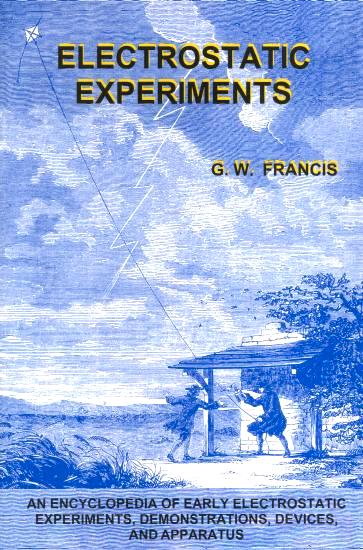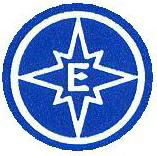Electrostatic Experiments
An Encyclopedia of Early Electrostatic Experiments, Demonstrations, Devices, and Apparatus, by G.W. Francis (author), Oleg Jefimenko (editor), (published by Electret Scientific, 2005, 273 pages)
Paperback - List Price US$ 28.00 |
|
Hardback - List Price US$ 48.00 |
Hardback is sold out. Please order the paperback. |
 Originally published in the middle of the nineteenth century under the title "Electrical Experiments", this book describes practically all basic electrostatic experiments, demonstrations, devices, and apparatus performed and invented since the time when the first electrostatic effects were noticed in antiquity up to about 1850. The book is unique in its comprehensiveness and provides all essential details for replicating over 400 electrostatic experiments and for reconstructing numerous electrostatic devices. Unfortunately, as is frequently the case with older books, the original editions of Francis's "Electrical Experiments" belong to the category of "rare books" hardly accessible now even to research scientists, to say nothing of students, teachers, engineers, amateur scientists, inventors, patent lawyers, and anyone else who may be interested in electrical science and in electrostatics in particular. And yet, the utility of Francis's book to a wide circle of readers is even greater now than when the book was first written because electrostatics has now become a very practical science with many useful applications, and therefore for many persons a familiarity with its basic principles and techniques is now truly important. The purpose of the present edition of Francis's remarkable work is to make it readily available and appealing to as wide a circle of readers interested in electrostatics as possible. The title of the book has been changed from "Electrical Experiments" to "Electrostatic Experiments". The word "electrical" in the original title, perfectly appropriate in the middle of the nineteenth century when the book was first published, is misleading to present-day readers: the book deals exclusively with electrostatics, whereas "electrical" is now mostly understood as something relating to the electric current. The book is printed in an entirely new format. Originally the book was printed in a very small typeface and its typographic quality was rather poor. The illustrations (wood engravings) were very small. The present format is designed for easy readability and pleasing visual appearance. The book is now printed in 11 points Century Schoolbook typeface - one of the most readable typefaces in existence. All 148 wood engravings originally contained in the book have been enlarged. Some words and terms used in the book have now either disappeared from the English language or have acquired a different meaning. Therefore the book has been now supplemented by a glossary explaining the most obscure or ambiguous words appearing in the book. Furthermore, taking into account that the most convenient presently-known generator of static electricity for performing electrostatic experiments is the Wimshurst's influence machine, invented some thirty years after the publication of Francis's book, the book has been supplemented by a description of this machine. Finally, the book has been supplemented by carefully selected pertinent literature references. Both the paperback edition and the hardcover edition are printed on high quality paper.
Originally published in the middle of the nineteenth century under the title "Electrical Experiments", this book describes practically all basic electrostatic experiments, demonstrations, devices, and apparatus performed and invented since the time when the first electrostatic effects were noticed in antiquity up to about 1850. The book is unique in its comprehensiveness and provides all essential details for replicating over 400 electrostatic experiments and for reconstructing numerous electrostatic devices. Unfortunately, as is frequently the case with older books, the original editions of Francis's "Electrical Experiments" belong to the category of "rare books" hardly accessible now even to research scientists, to say nothing of students, teachers, engineers, amateur scientists, inventors, patent lawyers, and anyone else who may be interested in electrical science and in electrostatics in particular. And yet, the utility of Francis's book to a wide circle of readers is even greater now than when the book was first written because electrostatics has now become a very practical science with many useful applications, and therefore for many persons a familiarity with its basic principles and techniques is now truly important. The purpose of the present edition of Francis's remarkable work is to make it readily available and appealing to as wide a circle of readers interested in electrostatics as possible. The title of the book has been changed from "Electrical Experiments" to "Electrostatic Experiments". The word "electrical" in the original title, perfectly appropriate in the middle of the nineteenth century when the book was first published, is misleading to present-day readers: the book deals exclusively with electrostatics, whereas "electrical" is now mostly understood as something relating to the electric current. The book is printed in an entirely new format. Originally the book was printed in a very small typeface and its typographic quality was rather poor. The illustrations (wood engravings) were very small. The present format is designed for easy readability and pleasing visual appearance. The book is now printed in 11 points Century Schoolbook typeface - one of the most readable typefaces in existence. All 148 wood engravings originally contained in the book have been enlarged. Some words and terms used in the book have now either disappeared from the English language or have acquired a different meaning. Therefore the book has been now supplemented by a glossary explaining the most obscure or ambiguous words appearing in the book. Furthermore, taking into account that the most convenient presently-known generator of static electricity for performing electrostatic experiments is the Wimshurst's influence machine, invented some thirty years after the publication of Francis's book, the book has been supplemented by a description of this machine. Finally, the book has been supplemented by carefully selected pertinent literature references. Both the paperback edition and the hardcover edition are printed on high quality paper.
